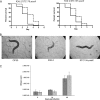A functional phenylacetic acid catabolic pathway is required for full pathogenicity of Burkholderia cenocepacia in the Caenorhabditis elegans host model
- PMID: 18776009
- PMCID: PMC2580687
- DOI: 10.1128/JB.00481-08
A functional phenylacetic acid catabolic pathway is required for full pathogenicity of Burkholderia cenocepacia in the Caenorhabditis elegans host model
Abstract
Burkholderia cenocepacia is a member of the Burkholderia cepacia complex, a group of metabolically versatile bacteria that have emerged as opportunistic pathogens in cystic fibrosis and immunocompromised patients. Previously a screen of transposon mutants in a rat pulmonary infection model identified an attenuated mutant with an insertion in paaE, a gene related to the phenylacetic acid (PA) catabolic pathway. In this study, we characterized gene clusters involved in the PA degradation pathway of B. cenocepacia K56-2 in relation to its pathogenicity in the Caenorhabditis elegans model of infection. We demonstrated that targeted-insertion mutagenesis of paaA and paaE, which encode part of the putative PA-coenzyme A (CoA) ring hydroxylation system, paaZ, coding for a putative ring opening enzyme, and paaF, encoding part of the putative beta-oxidation system, severely reduces growth on PA as a sole carbon source. paaA and paaE insertional mutants were attenuated for virulence, and expression of paaE in trans restored pathogenicity of the paaE mutant to wild-type levels. Interruption of paaZ and paaF slightly increased virulence. Using gene interference by ingested double-stranded RNA, we showed that the attenuated phenotype of the paaA and paaE mutants is dependent on a functional p38 mitogen-activated protein kinase pathway in C. elegans. Taken together, our results demonstrate that B. cenocepacia possesses a functional PA degradation pathway and that the putative PA-CoA ring hydroxylation system is required for full pathogenicity in C. elegans.
Figures






References
-
- Aballay, A., and F. M. Ausubel. 2002. Caenorhabditis elegans as a host for the study of host-pathogen interactions. Curr. Opin. Microbiol. 597-101. - PubMed
-
- Avery, L., and H. R. Horvitz. 1990. Effects of starvation and neuroactive drugs on feeding in Caenorhabditis elegans. J. Exp. Zool. 253263-270. - PubMed
-
- Cardona, S. T., and M. A. Valvano. 2005. An expression vector containing a rhamnose-inducible promoter provides tightly regulated gene expression in Burkholderia cenocepacia. Plasmid 54219-228. - PubMed
Publication types
MeSH terms
Substances
Associated data
- Actions
LinkOut - more resources
Full Text Sources

